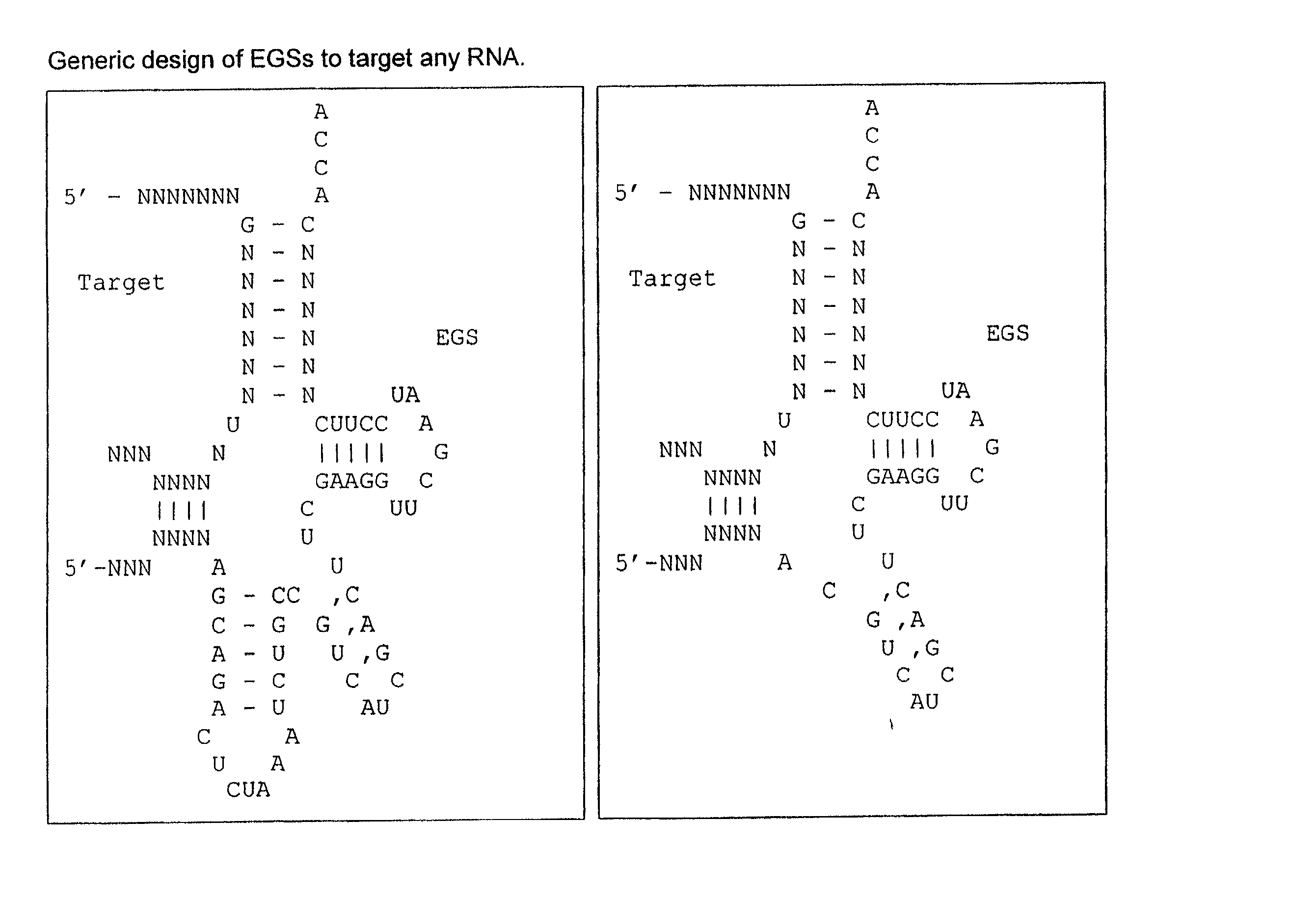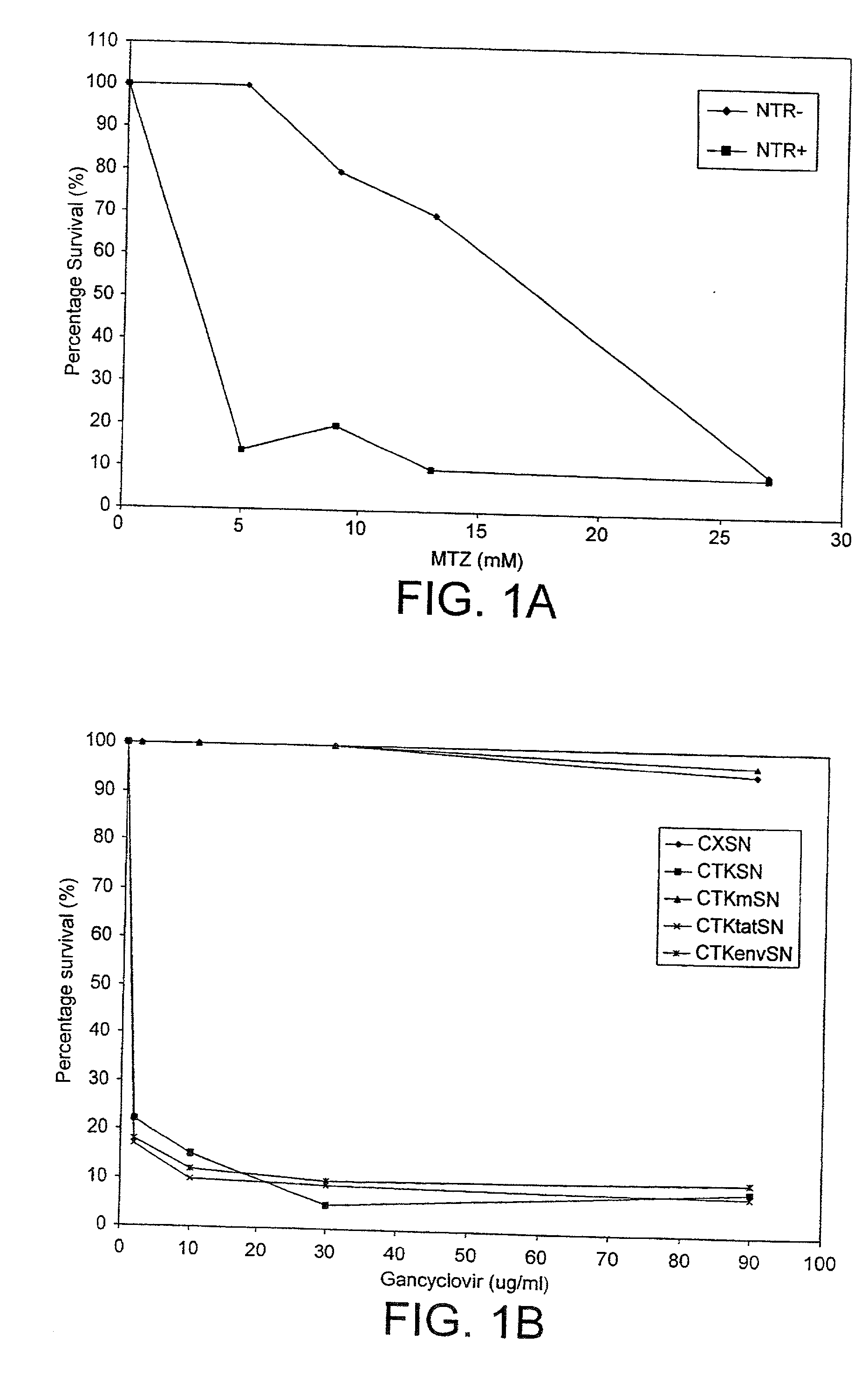In vivo selection method for determining inhibitory RNA molecules
a selection method and inhibitor technology, applied in the field of in vivo selection method for determining inhibitory rna molecules, can solve the problems of time-consuming generation of unique arrays, inability to predict the location of sites within mrna, and difficulty in application of such technology
- Summary
- Abstract
- Description
- Claims
- Application Information
AI Technical Summary
Benefits of technology
Problems solved by technology
Method used
Image
Examples
example 1
Selection of Prodrug System (Selectable Marker)
[0150] The second nucleotide used in the present invention encodes a detectable marker. We have chosen to exemplify the present invention using a enzyme-prodrug selection system. The dose response of two well-known enzyme-prodrug combinations was measured to select an effective prodrug system.
[0151] A. An E. coli Nitroreductase (NTR) / Metronidazole (MTZ) combination: HT1080 cells (NTR-) and HT1080 NTR positive cells (NTR+) were incubated with varying concentrations of MTZ and the percentage of cells which survived was measured (FIG. 1A).
[0152] B. An HSV-1 Thymidine kinase (TK) / Gancyclovir (GCV) combination: HeLa cell lines transduced with various viral vectors were treated for 72 hours with GCV and the percentage of cells which survived was measured (see FIG. 1B). CXSN=empty viral vector, CTKSN=TK positive virus, CTKmSN=TK mutant virus, CTKtatSN=vector containing the HIV-1 tat gene ORF downstream of an active TK gene (FIG. 4D), CTKenvSN=...
example 2
In vivo Selection Using Hammerhead Ribozymes
[0157] A library of hammerhead ribozymes is generated by random oligonucleotide synthesis. These are then inserted into CTKmSN (FIG. 4B) downstream of the inactive TK coding sequence to give a plurality of enzymes (CTKmRzLB--FIG. 4C).
[0158] CTKmSN (FIG. 4B) was constructed by removing the lacZ of pHIT111 (Soneoka et al. 1995) (FIG. 4A) to give the intermediate construct CKSN (FIG. 4A) and then inserting in its place an inactive TK coding sequence constructed by a frameshift mutation (cut and re-fill at BsP EI site). The sequence of human herpes virus 1 is provided in Wagner et al., 1981 (Genbank accession no. V00467).
[0159] Insertion of the library downstream of the inactive form of the enzyme is necessary to ensure that no ribozymes that cut the TK containing RNA (and therefore would lead to false positives in the selection) are contained in the vector library. Virus was generated by the three plasmid co-transfection system (Soneoka et al...
example 3
In vivo Testing Using Optimised Ribozymes
[0162] The optimised ribosomes obtained according to Example 1 may be used in the treatment of diseases. In particular, a number of these ribozymes may be used in tandem allowing the targeting of a number of sites. In addition, in the treatment of HIV, an HIV vector can be used to deliver the ribozymes, as this will cause interference with the packaging of the wild type genome.
[0163] To test the feasibility of this approach we tested an anti-tat ribozyme on a tat stable cell line. As shown in FIG. 3, it is possible to select for cells that contain the functional ribozyme. It is also clear that the bystander effect has to be eliminated to be able to perform such a selection.
[0164] This technique could be used to find ribozymes specific for all parts of the HIV genome. In addition this method provides a means to isolate in vivo relevant ribozymes for any RNA target.
PUM
| Property | Measurement | Unit |
|---|---|---|
| stability | aaaaa | aaaaa |
| secondary structure | aaaaa | aaaaa |
| time | aaaaa | aaaaa |
Abstract
Description
Claims
Application Information
 Login to View More
Login to View More - R&D
- Intellectual Property
- Life Sciences
- Materials
- Tech Scout
- Unparalleled Data Quality
- Higher Quality Content
- 60% Fewer Hallucinations
Browse by: Latest US Patents, China's latest patents, Technical Efficacy Thesaurus, Application Domain, Technology Topic, Popular Technical Reports.
© 2025 PatSnap. All rights reserved.Legal|Privacy policy|Modern Slavery Act Transparency Statement|Sitemap|About US| Contact US: help@patsnap.com



